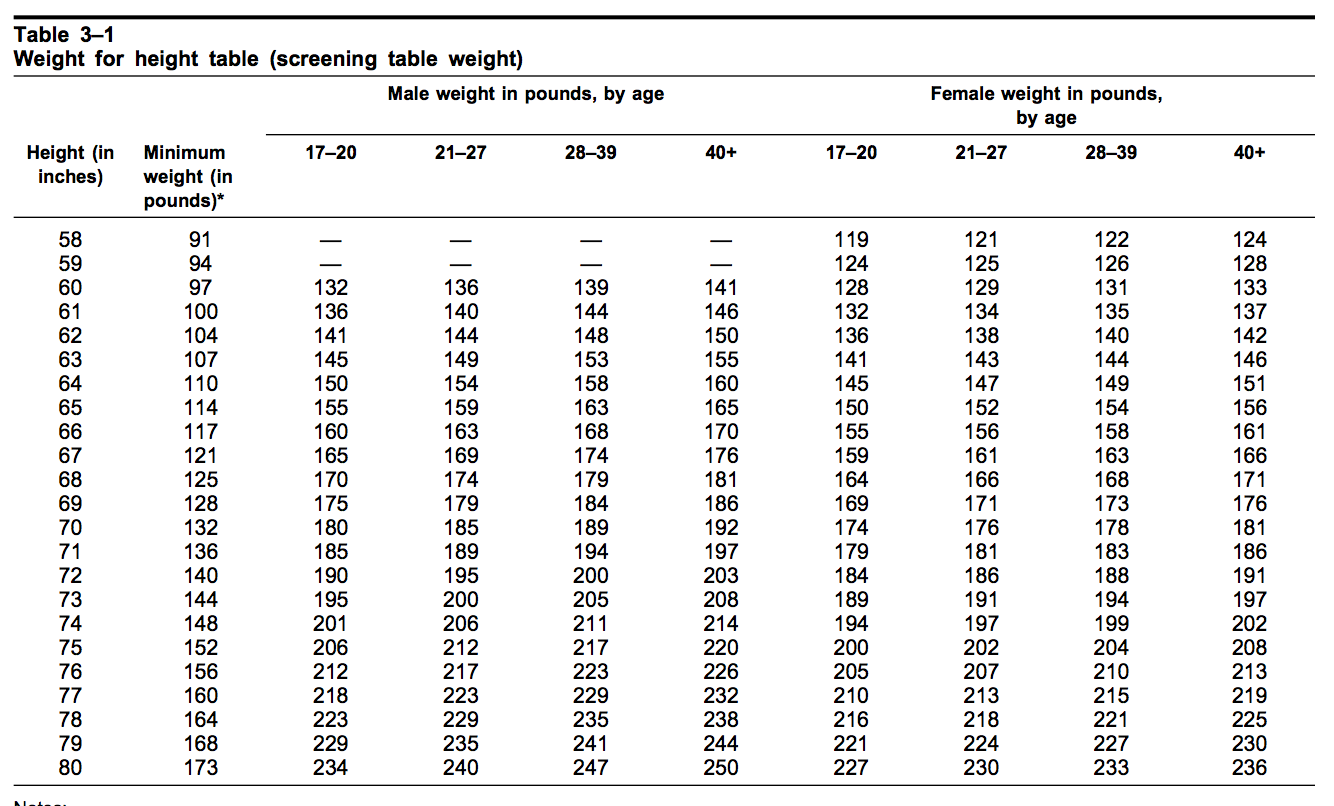The Army height and weight chart plays a critical role in maintaining the physical standards necessary for military service. These standards ensure that all personnel are fit for duty and capable of meeting the demands of their roles. The chart serves as a guideline for potential recruits and current soldiers to assess their eligibility based on their height and weight ratios. It is essential for individuals aiming to enlist or continue their service to understand these criteria fully and the implications of failing to meet them.
In the military, physical fitness is paramount. Soldiers must be in optimal condition, not just for their personal safety but for the safety of their comrades as well. The Army height and weight chart is a part of the Army's overall fitness program, which includes various assessments to determine a soldier's physical readiness. Understanding how to interpret this chart can help soldiers maintain their health and readiness for duty.
Furthermore, the Army height and weight standards are not merely arbitrary numbers; they are based on extensive research and data regarding physical fitness and health. This article will delve deeper into the significance of the Army height and weight chart, how it is applied, and what it means for current and prospective soldiers. Whether you’re contemplating enlistment or are currently serving, knowing this information is crucial.
What is the Army Height and Weight Chart?
The Army height and weight chart is a tool used by the United States Army to ensure that soldiers meet specific physical requirements. It outlines the acceptable height and weight ranges based on gender and age. The primary goal of this chart is to promote overall fitness and operational readiness among soldiers. It is important to note that being within the weight limits does not solely determine a soldier's fitness; body composition and physical performance are also significant factors.
Why is the Army Height and Weight Chart Important?
The Army height and weight chart is important for several reasons:
- It helps maintain a standard of physical fitness among soldiers.
- It supports operational readiness and effectiveness in the field.
- It promotes a culture of health and wellness within the military.
- It aids in identifying soldiers who may need additional support in their fitness journey.
How is the Army Height and Weight Chart Utilized?
The Army height and weight chart is utilized during the enlistment process and regularly throughout a soldier's career. At the time of enlistment, potential recruits are weighed and measured to ensure they meet the required standards. Once enlisted, soldiers are periodically assessed to ensure they maintain these standards. Failure to meet the height and weight requirements can lead to remedial actions, including counseling and possible separation from service.
What Happens if Soldiers Don't Meet the Standards?
When soldiers do not meet the height and weight standards set forth in the Army height and weight chart, several consequences may occur:
- Increased monitoring and counseling on fitness.
- Mandatory participation in weight control programs.
- Potential eligibility concerns for promotions or special assignments.
- In extreme cases, discharge from the military may occur.
Can Soldiers Improve Their Physical Fitness?
Yes, soldiers can significantly improve their physical fitness through various means, including:
- Regular exercise and physical training.
- Maintaining a balanced diet tailored to their fitness goals.
- Participating in group fitness programs or military fitness classes.
- Setting and tracking personal fitness goals.
What Are the Specifics of the Army Height and Weight Chart?
The specifics of the Army height and weight chart vary by gender and age group. Below is an overview of the standards:
| Gender | Age Group | Height (inches) | Weight (lbs) |
|---|---|---|---|
| Male | 17-20 | 64-80 | 110-265 |
| Female | 17-20 | 58-78 | 90-240 |
| Male | 21-27 | 64-80 | 110-265 |
| Female | 21-27 | 58-78 | 90-240 |
| Male | 28-39 | 64-80 | 110-265 |
| Female | 28-39 | 58-78 | 90-240 |
| Male | 40+ | 64-80 | 110-265 |
| Female | 40+ | 58-78 | 90-240 |
How to Measure Your Height and Weight Correctly?
Measuring height and weight accurately is crucial for assessing fitness. Here’s how to ensure you measure correctly:
- Height: Stand straight against a wall with your heels together, feet flat on the ground, and look straight ahead. Use a flat object to mark the top of your head against the wall.
- Weight: Use a reliable scale, preferably one that is calibrated, and weigh yourself at the same time of day for consistency.
Are There Exceptions to the Army Height and Weight Chart?
Yes, there are exceptions based on various factors, such as age, body composition, and current physical fitness level. Soldiers may be eligible for alternate assessments, such as body fat measurements, if they do not meet the height and weight standards. It is essential to consult with a fitness or medical professional within the Army for guidance.
Conclusion: The Importance of Adhering to the Army Height and Weight Chart
Understanding and adhering to the Army height and weight chart is vital for all soldiers. It not only affects enlistment and career progression but also plays a crucial role in personal health and fitness. Soldiers are encouraged to maintain their physical fitness and seek assistance if they struggle to meet the standards. The commitment to fitness exemplifies the Army's core values and ensures that all personnel are prepared for the challenges they may face in service.
Unveiling The Enigma: The Big Justice Height
Unraveling The Controversy: Barron Trump And Allegations Of Animal Cruelty
Unveiling The Life Of CD Lamb's Wife: A Journey Beyond The Spotlight


